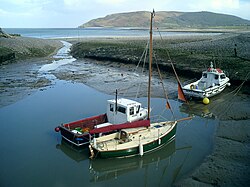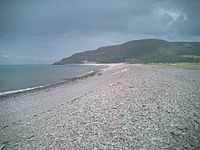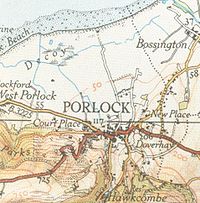Porlock
| Porlock | |
| Somerset | |
|---|---|
 Porlock Weir | |
| Location | |
| Grid reference: | SS886467 |
| Location: | 51°12’32"N, 3°35’44"W |
| Data | |
| Population: | 1,440 (2011) |
| Post town: | Minehead |
| Postcode: | TA24 |
| Dialling code: | 01643 |
| Local Government | |
| Council: | Somerset |
| Parliamentary constituency: |
Bridgwater & W. Somerset |
| Website: | Website |
Porlock is a coastal village in Somerset, five miles west of Minehead. It is within the Exmoor National Park.
At the 2011 census, the village had a population of 1,440. In 2017, Porlock was calcualted as having the highest percentage of elderly population in Britain,[1] with over 40% being of pensionable age as of 2010.[2]
Contents
History
East of the village is Bury Castle, an Iron Age hill fort.
There is evidence for 10th or 11th century origin for the name Porlock as Portloc or Portloca, meaning enclosure by the harbour, from the Old English port and loca,[3] and in the Domesday Book the village was known as "Portloc".[4] In 914 the Vikings plundered Porlock.[5]
The area has links with several Romantic poets, and R. D. Blackmore, the author of Lorna Doone, and is popular with visitors. The visitor centre has exhibits and displays about the local area. Also on display are the bones of an aurochs, discovered on Porlock beach in 1999.[6]
Geography
The village adjoins the Porlock Ridge and Saltmarsh nature reserve, created from the lowland behind a high shingle embankment which was breached by the sea in the 1990s, which has now been designated as a Site of Special Scientific Interest. Copses of white dead trees remind the visitor of when this was freshwater pasture.
A stream flows down a wooded combe called Hawkcombe leads about three miles from the village up to high open moorland. The stream, called "Hawkcombe Waters", runs past a Victorian hunting lodge, called The Cleeve, then underground beneath the Overstream Hotel in the centre of the village.
The South West Coast Path goes through Porlock, many walkers stopping rather than continuing the long walk to Lynton. There is also a 'Coleridge Way' walk.
Culbone Church is said to be the smallest church in Church of England.[7] The main structure is 12th century. Services are still held there, despite the lack of road access – Culbone is a two-mile walk from Porlock Weir, and some 3 to 4 miles from Porlock itself.
A toll road bypasses the 1 in 4 gradient on Porlock Hill.
A prehistoric stone circle, Porlock Stone Circle, stands on the hill.[8]
Submerged forest
At low tide the remains of a submerged forest can be seen on Porlock Beach. The area was several miles inland until the sea level in the Bristol Channel rose about 7000 to 8000 years ago.[9]
Church
The Church of St Dubricius dates from the 13th century. The spire was damaged in a storm of 1703.[4] The church is a Grade I listed building.[10]
Within the church is a 15th-century tomb of John Harrington who fought alongside Henry V in France in 1417.[11]
Cultural references
"Person on business from Porlock"
In 1797, poet Samuel Taylor Coleridge, who lived nearby at Nether Stowey (between Bridgwater and Minehead), but — due to illness — had "retired to a lonely farm house between Porlock and Lynton",[12] was interrupted during composition of his poem Kubla Khan by "a person on business from Porlock", and claimed he found afterwards he could not remember what had come to him in a dream.
Coleridge and William Wordsworth (who lived nearby at Alfoxden) would often roam the hills and coast on long night walks, leading to local gossip that they were 'spies' for the French. The Government sent an agent to investigate, but found they were "mere poets". Their walks are celebrated by the Coleridge Way which ends in Porlock. Their friend Robert Southey published a poem titled "Porlock" in 1798.
Other cultural references
A song, titled "Another one from Porlock", is found on the Penguin Cafe Orchestra album Union Cafe. In Iris Murdoch's "Bruno's Dream", Miles admonishes Diana for porlocking while he is trying to receive poetic inspiration.
The Song "13 Miles" by the punk folk band Skinny Lister details the story of the 1899 Lynmouth lifeboat launch from Porlock; where a lifeboat had to be carried 13 miles over the moor due to poor weather conditions at Lynmouth Lifeboat Station. The launch saved all 18 souls stranded at sea.
Outside links
| ("Wikimedia Commons" has material about Porlock) |
References
- ↑ Moss, Stephen (2017-12-09). "'Older people have pulled up the ladder': inside England's oldest and youngest towns | Inequality | The Guardian". https://amp.theguardian.com/inequality/2017/dec/09/ladder-england-oldest-youngest-towns-manchester-minehead.
- ↑ Ramesh, Randeep (26 May 2010). "People in rural areas live longer, says study". The Guardian. https://www.theguardian.com/uk/2010/may/25/rural-idyll-boots-life-expectancy.
- ↑ "History of Porlock Weir". http://www.exmoorher.co.uk/hbsmr-web/record.aspx?UID=MEM15232-Porlock.
- ↑ 4.0 4.1 Farr, Grahame (1954). Somerset Harbours. London: Christopher Johnson. p. 154.
- ↑ Lewis, Stephen M.. "Óttar's Story – A Dublin Viking in Brittany, England and Ireland, A.D. 902-918". https://www.academia.edu/9155941.
- ↑ "Porlock Visitor Centre". Everything Exmor. http://www.everythingexmoor.org.uk/_P/Porlock_Visitor_Centre.php.
- ↑ "Parish Churches". Somerset County archives. http://www.somerset.gov.uk/archives/ASH/Parishchs.htm.
- ↑ Megalithic Portal: Porlock Circle
- ↑ "Geological features". Exmoor National Park. http://www.exmoor-nationalpark.gov.uk/index/learning_about/looking_after_landscape/geology/geological_features.htm.
- ↑ National Heritage List 1173524: Church of St Dubricius (Grade I listing)
- ↑ Leete-Hodge, Lornie (1985). Curiosities of Somerset. Bodmin: Bossiney Books. p. 45. ISBN 0-906456-98-3.
- ↑ Samuel Taylor Coleridge, Christabel, Kubla Khan, and the Pains of Sleep, 2nd edition, William Bulmer, London, 1816. Reproduced in The Complete Poems, ed. William Keach, Penguin Books, 2004.

